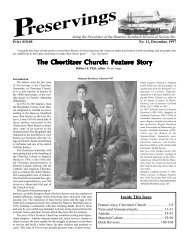Preservings $20 No. 25, December, 2005 - Home at Plett Foundation
Preservings $20 No. 25, December, 2005 - Home at Plett Foundation
Preservings $20 No. 25, December, 2005 - Home at Plett Foundation
Create successful ePaper yourself
Turn your PDF publications into a flip-book with our unique Google optimized e-Paper software.
e found in The Bloody The<strong>at</strong>re, or Martyrs’<br />
Mirror. 11 According to the account, van Bylaert<br />
and twenty fellow believers were imprisoned in<br />
1575 in London, England. Hendrick Terwoort<br />
and Jan Pietersz, both Flemish refugees, were<br />
subsequently executed. Two persons died in<br />
prison, fifteen were expelled and two others<br />
eventually survived prison. Among the l<strong>at</strong>ter was<br />
van Bylaert. L<strong>at</strong>er, van Bylaert lived in the Dutch<br />
merchant town of Dordrecht, where he became<br />
elder of the Old-Flemish congreg<strong>at</strong>ion sometime<br />
before 1611 Besides governing the local church,<br />
van Bylaert was a silversmith by profession. He<br />
was a coin-maker <strong>at</strong> the Dordrecht Munt, and<br />
also became one of the first coin-makers in 1586<br />
for the St<strong>at</strong>es-General of the Netherlands. 12 Gerard<br />
van Bylaert died October 12th, 1617.<br />
Jacques Verbeeck worked alongside van Bylaert.<br />
Both elders seem to have been irenic men.<br />
Verbeeck was elder of the Utrecht congreg<strong>at</strong>ion<br />
as early as 1611. His name hints <strong>at</strong> his Flemish<br />
origins. By profession Verbeeck was a silk<br />
merchant. He was married to Segerina Caffa.<br />
Verbeeck died shortly before the unific<strong>at</strong>ion of<br />
the Flemish and Old-Flemish <strong>at</strong> Dordrecht in<br />
1632, namely <strong>December</strong> 23rd, 1627.<br />
As we have already seen, Lucas Philips<br />
argued with Vincent de Hont in 1619/20 over<br />
the ban of a groom who had tre<strong>at</strong>ed his bride<br />
indecently. Philips was a h<strong>at</strong>ter by profession,<br />
and probably resided <strong>at</strong> Woerden until 1618, a<br />
town in the province of Utrecht. He led his small<br />
Haarlem congreg<strong>at</strong>ion until his de<strong>at</strong>h, sometime<br />
after 1640. One would perhaps think th<strong>at</strong> Philips<br />
belonged to the progressives among the Old-<br />
Flemish. To be true, the congreg<strong>at</strong>ion of Philips<br />
was no less strict about the ban and shunning<br />
(mijding) than the congreg<strong>at</strong>ion of his adversary<br />
Vincent de Hont. When asked in 1675 wh<strong>at</strong> he<br />
thought of the l<strong>at</strong>ter congreg<strong>at</strong>ion, Abraham<br />
Tack, then the preacher of the congreg<strong>at</strong>ion of<br />
Philips, answered th<strong>at</strong> they should be considered<br />
branches th<strong>at</strong> did not belong to the vine of<br />
Christ. They should be thrown into the fire.<br />
Jan Willems was elder of the Haarlem<br />
congreg<strong>at</strong>ion as early as 1611. He must not be<br />
identified with the Frisian elder <strong>at</strong> Hoorn or<br />
the W<strong>at</strong>erlander elder <strong>at</strong> Haarlem of the same<br />
name. His profession was th<strong>at</strong> of a cloth maker.<br />
As st<strong>at</strong>ed above, he played an important role<br />
in the ongoing quarrel with the Amsterdam<br />
congreg<strong>at</strong>ion in the years 1616-17. 13 He gives<br />
the impression of having been a firm, but peaceloving,<br />
man. Jan Willems died <strong>at</strong> Haarlem on<br />
October 13th, 1617.<br />
Cornelis van Male probably came from<br />
Cologne, which was for a time a major refuge<br />
for Mennonites and Reformed. He was elder of<br />
the Amsterdam congreg<strong>at</strong>ion. In 1615, when first<br />
mentioned, he was already an old man. From the<br />
narr<strong>at</strong>ive of the Amsterdam quarrel we get the<br />
impression th<strong>at</strong> he did not hold much authority<br />
over his preachers.<br />
Near Rotterdam lay the harbour of Delfshaven.<br />
To citizens of the United St<strong>at</strong>es the<br />
name of this harbour should sound familiar,<br />
because the Pilgrim F<strong>at</strong>hers began their journey<br />
<strong>at</strong> Delfshaven. The elder of the small local Old-<br />
Flemish congreg<strong>at</strong>ion was Hendrick Ghuyten.<br />
Ordinances in the Netherlands: 1. Communion with wine; 2. Communion with Bread. (Mennonite Encyclopedia<br />
IV, photo section p. 3)<br />
Like most inhabitants of Delfshaven, he was a<br />
sailor, a helmsman to be precise, on a herring<br />
ship. Already a preacher in 1609, Ghuyten was<br />
ordained as elder shortly after 1617. As such he<br />
not only served his own congreg<strong>at</strong>ion, but also<br />
those of neighbouring Rotterdam and Dordrecht.<br />
He was instrumental in electing Adriaen<br />
Cornelis as elder of the Dordrecht congreg<strong>at</strong>ion.<br />
Ghuyten died October, 16th, 1624. 14<br />
Old-Flemish elders from 1620-1670<br />
This section provides a survey of the elders<br />
serving from the 1620s to the 1670s. We have<br />
already come across Lucas Philips, so it is now<br />
time to pay <strong>at</strong>tention to his opponent, Vincent de<br />
Hont. Like many refugees, his f<strong>at</strong>her fled from<br />
the Flemish town of Rumbeeke to Haarlem.<br />
Haarlem was a centre of the textile industry and<br />
drew many Flemish fugitives. De Hont was born<br />
in Roesselaar in 1561. 15 By profession he was a<br />
merchant who had dealings as far away as Spain<br />
and France. De Hont was already a preacher of<br />
the large Haarlem congreg<strong>at</strong>ion in 1606. After<br />
the breakup of the congreg<strong>at</strong>ion in 1620, de<br />
Hont served his church as elder until his de<strong>at</strong>h.<br />
Vincent de Hont was the author of several books:<br />
Vertooninghe en verantwoordignge tot dienste<br />
van allen onse medegenooten des geloofs (Haarlem,<br />
1619, authorship probable), his confession<br />
Korte bekentenisse des geloofs (Haarlem, 1626)<br />
and Een korte en grondige verklaring van de<br />
vrede Godts (Haarlem, 1632). Van der Zijpp depicts<br />
de Hont as having an “implacable <strong>at</strong>titude.”<br />
This estim<strong>at</strong>e seems unreasonable, because the<br />
largest part of the congreg<strong>at</strong>ion and most of<br />
his fellow ministers followed de Hont after the<br />
<strong>Preservings</strong> <strong>No</strong>. <strong>25</strong>, <strong>December</strong> <strong>2005</strong> - 37
















